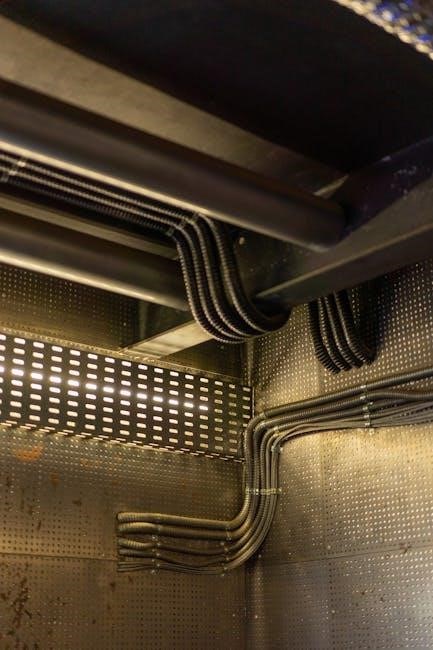Shigleys Mechanical Engineering Design provides comprehensive coverage of mechanical engineering design principles and methods using pdf resources for easy access and learning purposes always online.
Overview of the Book
Shigleys Mechanical Engineering Design is a widely used textbook that provides a comprehensive overview of mechanical engineering design principles and methods. The book is written by Richard G. Budynas and J. Keith Nisbett, and it is now in its eighth edition. According to the information available on the internet, the book covers a wide range of topics, including materials, load and stress analysis, deflection and stiffness, and failure prevention. The book is designed to provide students and engineers with a thorough understanding of the principles and methods of mechanical engineering design. It includes many examples and case studies to illustrate the application of these principles and methods. The book is available in various formats, including pdf, and it can be downloaded from various online sources. The book is a valuable resource for anyone interested in mechanical engineering design, and it is widely used in universities and industries around the world.

Contents of the Book
Shigleys Mechanical Engineering Design book contains various chapters and topics using pdf format for easy access always online every day.
Part 1: Basics
Part 1 of Shigleys Mechanical Engineering Design covers the fundamental principles of mechanical engineering design, including introduction to mechanical engineering design, materials, load and stress analysis, and deflection and stiffness. The chapters in this part provide a comprehensive overview of the basics of mechanical engineering design.
Using pdf resources, students can easily access and learn from the book.
The topics covered in this part are essential for understanding the more advanced concepts discussed in later parts of the book.
The book uses a combination of theoretical and practical approaches to explain the concepts, making it easier for students to understand and apply them in real-world scenarios.
Overall, Part 1 of Shigleys Mechanical Engineering Design provides a solid foundation for further study and practice in mechanical engineering design, with the pdf format making it convenient to access and review the material.
Part 2: Failure Prevention
Part 2 of Shigleys Mechanical Engineering Design focuses on failure prevention, which is a critical aspect of mechanical engineering design; The chapters in this part discuss failures resulting from static loading, fatigue failure resulting from variable loading, and other types of failures.
Using pdf resources, students can learn about the different modes of failure and how to prevent them.
The book provides detailed explanations of the failure prevention methods, including the use of safety factors, stress analysis, and material selection.
The topics covered in this part are essential for designing mechanical systems that are reliable and safe.
The book also discusses the importance of considering the potential causes of failure during the design process, and how to use pdf tools to analyze and prevent failures.
By understanding the principles of failure prevention, mechanical engineers can design systems that are more efficient, reliable, and cost-effective, using the knowledge gained from Shigleys Mechanical Engineering Design pdf resources.

Design of Mechanical Elements
Shigleys Mechanical Engineering Design provides detailed information on designing mechanical elements using various methods and techniques always online available.
Chapter 7: Design of Mechanical Elements
Chapter 7 of Shigleys Mechanical Engineering Design focuses on the design of mechanical elements, including gears, shafts, and bearings. The chapter provides detailed information on the design process, including the selection of materials and the calculation of stresses and strains. The use of pdf resources allows for easy access to the chapter’s content, including equations, diagrams, and examples. The design of mechanical elements is a critical aspect of mechanical engineering, and this chapter provides a comprehensive overview of the key principles and methods. By following the guidelines and procedures outlined in the chapter, engineers can design mechanical elements that are safe, efficient, and reliable. The chapter’s content is supported by numerous examples and case studies, making it a valuable resource for students and practicing engineers alike, using online resources for further learning and reference.

Importance of the Book
Shigleys Mechanical Engineering Design is a valuable resource for engineers, providing essential knowledge and skills for successful design and development of mechanical systems always online available.
Target Audience
The target audience of Shigleys Mechanical Engineering Design includes students and professionals in the field of mechanical engineering, who require a comprehensive understanding of design principles and methods.
Using pdf resources, instructors can integrate the book into their courses, providing students with a valuable learning tool.
The book is also suitable for engineers working in industry, who need to design and develop mechanical systems and components.
With its clear explanations and numerous examples, Shigleys Mechanical Engineering Design is an ideal resource for anyone looking to improve their knowledge and skills in mechanical engineering design.
The book’s coverage of topics such as materials, load and stress analysis, and failure prevention makes it a valuable asset for engineers working in a variety of fields, including aerospace, automotive, and manufacturing.
Overall, the target audience of Shigleys Mechanical Engineering Design is anyone who requires a thorough understanding of mechanical engineering design principles and methods.

Availability of the Book
Shigleys Mechanical Engineering Design is available online as a pdf download from various websites and online stores always.
Download Options
Shigleys Mechanical Engineering Design pdf is available for download from various online sources, including academic websites and online stores. The book can be downloaded in pdf format, making it easily accessible on various devices. Users can search for the book on search engines and download it from reputable websites. Additionally, many online libraries and repositories offer free downloads of the book. Some websites also offer downloadable solutions manuals and instructor resources to accompany the book. To download the book, users can simply click on the download link and save the pdf file to their device. It is important to ensure that the download is from a reputable source to avoid any potential risks or malware. By downloading Shigleys Mechanical Engineering Design pdf, users can access the book’s comprehensive coverage of mechanical engineering design principles and methods, including topics such as materials, load and stress analysis, and failure prevention. The download options are convenient and easily accessible, making it a popular choice among students and professionals in the field of mechanical engineering. The book’s content is well-organized and easy to follow, with many examples and illustrations to support the text. Overall, downloading Shigleys Mechanical Engineering Design pdf is a great way to access this valuable resource.
Shigleys Mechanical Engineering Design pdf provides valuable resources using online materials for engineering students and professionals always available online easily.
The book Shigleys Mechanical Engineering Design provides a comprehensive overview of mechanical engineering design principles and methods, covering topics such as materials, load and stress analysis, and failure prevention; The book is divided into several parts, each focusing on a specific aspect of mechanical engineering design. The book also includes a range of examples and case studies to illustrate key concepts and principles. Additionally, the book is available in pdf format, making it easily accessible to students and professionals. The pdf version of the book can be downloaded from various online sources, providing a convenient way to access the book’s content. Overall, the book is a valuable resource for anyone involved in mechanical engineering design, providing a thorough understanding of the principles and methods involved. The book’s content is well-organized and easy to follow, making it a useful tool for both students and professionals in the field of mechanical engineering.